Intro
-- Travel back in
time with me to the period of the American Revolution. I
will display and describe flags that flew
over Revolutionary Georgia, along with key personalities and events associated
with each flag. But first, can you name the Flag
that was flown over the American Colonies- including Georgia, longer than any
other? -
Answer is the British
Union Flag,
or more commonly
called the Union Jack -- Starting 175 years before the Revolution in
Jamestown (1601) and Plymouth (1620), Americans pledged allegiance to the
Union Flag, the
official flag of
British monarchs.
1--British Flags-–
Display: Union Flag & British Red Ensign
This
Union Flag, with the red cross of St. George placed over the diagonal
white cross of St. Andrew on a blue field, represents the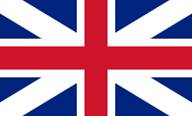 Union of England, Wales and Scotland which occurred in 1606. As
the official
flag of the monarch- also called the King’s Colors,
it served as the
National flag of Great Britain and each of its Colonies-- including America.
This Union Flag has been prominently displayed in Georgia since its inception,
including here at Fort King George and at Fort Frederica on St. Simons.
Union of England, Wales and Scotland which occurred in 1606. As
the official
flag of the monarch- also called the King’s Colors,
it served as the
National flag of Great Britain and each of its Colonies-- including America.
This Union Flag has been prominently displayed in Georgia since its inception,
including here at Fort King George and at Fort Frederica on St. Simons.
“Ensign”
is the name of a flag which identifies the nationality of sea-going vessels.
This British Red Ensign,
incorporating the small
 Union symbol on a field of
red, was displayed on all British man-of-war and merchant ships, and before
1776, on all American merchant ships—when it was called the Colonial Red
Ensign. This flag was flown on Royal governmental buildings in the
American colonies, including Savannah, prior to the American Revolution. I
will explain how the Red Ensign
was a precursor of several flags of Colonial protest as well as our first
American flags.
Union symbol on a field of
red, was displayed on all British man-of-war and merchant ships, and before
1776, on all American merchant ships—when it was called the Colonial Red
Ensign. This flag was flown on Royal governmental buildings in the
American colonies, including Savannah, prior to the American Revolution. I
will explain how the Red Ensign
was a precursor of several flags of Colonial protest as well as our first
American flags.
Georgia flourished under
the leadership of Royal Governor James Wright; the economy blossomed, the
territory tripled, and an influx of new settlers greatly expanded the
population. Georgians loved Governor Wright – AND King George III--until the
Savannah Liberty Boys, encouraged by rebels in Massachusetts, began to disrupt
the operations of The Royal government. Would you believe the Liberty Boys
arrested Governor Wright and made him a captive in his own Residence?
One morning in March of
1776, two British warships appeared in the Savannah Harbor, both flying the
Red Ensign. The ship’s Captain wanted to purchase rice for British soldiers in
Boston, but the rebels fired on the British warships who then retaliated, in
an action called, the Battle of the Riceboats. In the confusion, Governor
Wright fled to the British ship, H.M.S. Scarborough and later sailed to
England. (Wright Square in Brunswick is named for Royal Governor James Wright)
After the war
bogged down in the North, the
British Generals decided to implement their Southern Strategy. By mobilizing
the Loyalist Militia in Georgia, the Carolinas, and Virginia, they expected to
put down the rebellion, at least in the Southern colonies.
In
late November 1778,
Lt. Colonel
Archibald Campbell and
3,000 British
troops sailed from New York in
a large
flotilla of warships, all proudly flying the
Red Ensign. Following the quick capture of Savannah,
Governor Wright was able to return, after three years in exile, and
re-establish the British Colonial government. Flying the Union Flag
over
official buildings in Savannah, the British implemented the first part their
Southern Strategy.
Two
months later, when the British troops routed the Rebels at Brier Creek north
of Savannah, they then controlled all of Georgia again, except for the
“hornet’s nest” in Wilkes County. As
Col. Campbell said: "I may venture to say I have ripped one star and one
stripe from the rebel flag of America."
The
Union Flag and Red Ensign
continued to be displayed in Georgia until the British evacuation of Savannah
in July 1782….Can you recall the name of the group which led the rebellious
activities in Boston prior to the Revolution?
Answer is the Sons of
Liberty- who also created an early American flag
displayed in the colonies.
2--
Liberty Flags--
Display: Liberty, Taunton &
American Liberty flags
Joseph
Warren, Paul Revere and Samuel Adams were among the members of the
Sons of Liberty in Boston, or more commonly,
 called the Liberty Boys. Dedicated to colonial resistance, they protested the
British Parliament’s punishment for what they called, our “Tea Party.” The
Liberty Boys organized mass rallies, first in Boston, and then in many
different communities. Recognizing the need for a unique American flag, the
Liberty Boys created this Sons of Liberty flag, and raised it on an Elm
tree in Boston. When British soldiers cut down the tree, the flag was raised
on a Liberty Pole, first in Boston and then throughout the colonies. The flag,
also called Liberty flag with thirteen red and white stripes, signified
the Unity of the Colonies against
Parliament’s unfair duties and taxation, and was
called the “Rebellious Stripes” flag by the British.
called the Liberty Boys. Dedicated to colonial resistance, they protested the
British Parliament’s punishment for what they called, our “Tea Party.” The
Liberty Boys organized mass rallies, first in Boston, and then in many
different communities. Recognizing the need for a unique American flag, the
Liberty Boys created this Sons of Liberty flag, and raised it on an Elm
tree in Boston. When British soldiers cut down the tree, the flag was raised
on a Liberty Pole, first in Boston and then throughout the colonies. The flag,
also called Liberty flag with thirteen red and white stripes, signified
the Unity of the Colonies against
Parliament’s unfair duties and taxation, and was
called the “Rebellious Stripes” flag by the British.
For over ten years,
Liberty Boys met in Savannah to express their grievances against the British
Crown.
One of their
meeting places,
Peter Tondee's Tavern, was at the corner of Broughton and Whitaker
streets. Have you heard of the “Savannah Sugar Party”? Disguised as sailors
with blackened faces, the Liberty Boys went to the Battery, and recaptured
sugar and molasses which had been seized by Governor Wright’s customs
officials for non-payment of import duties. Next, they liberated 600 pounds
of gunpowder stored in the Royal Magazine. Then, the Liberty Boys raised the
Liberty flag on a Liberty Pole in Johnson Square, and paraded under arms with
fixed bayonets around the pole. Of course, “boys will be boys” —so they drank
a series of toasts: first to “The King,” but second to “American Liberty.”
This was the first Revolutionary flag displayed in the southern colonies.
(This Liberty Flag is displayed at the back of the historic St. Paul’s
Episcopal Church in Augusta along with other Revolutionary Flags.)

Unique
Protest or Liberty flags appeared in each of the colonies—some with blue
fields while others were red. On one, the Taunton flag, colonists
defiantly defaced the British Red Ensign by adding “LIBERTY AND UNION” on its
red field, reflecting the need to unify the 13 colonies.
The
Liberty flag created in Georgia was a simple white
banner with a red border and the words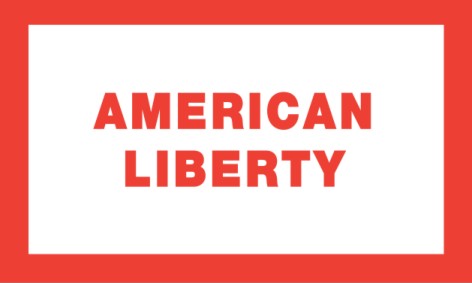 "AMERICAN LIBERTY" printed in bold red
letters. A Georgia Navy Schooner, named Liberty and flying this
America Liberty Flag, captured the first
British vessel in Southern waters, a powder ship
near Tybee Island. The Georgia Navy Galleys
proudly flew this Liberty flag from their main mast when they patrolled the
tidal rivers, including the Naval Victory at
Frederica in April of 1778.
"AMERICAN LIBERTY" printed in bold red
letters. A Georgia Navy Schooner, named Liberty and flying this
America Liberty Flag, captured the first
British vessel in Southern waters, a powder ship
near Tybee Island. The Georgia Navy Galleys
proudly flew this Liberty flag from their main mast when they patrolled the
tidal rivers, including the Naval Victory at
Frederica in April of 1778.
Based on Gov.
Wright’s outstanding leadership, most Georgians favored King George, but news
of the fighting at Lexington and Concord in 1775 caused alliances to
dramatically change. Many Georgians joined those in other colonies to begin
the Fight for Independence…………General
George Washington needed a flag
to celebrate the formation of the Continental
Army. Can anyone recall the name of that flag?
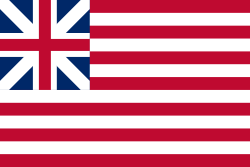 Inspired
by the “Unity Stripes” of
the Liberty flag, this
flag—called Grand Union was created by adding
six
white horizontal stripes to the red field of the British Red Ensign. The
Union symbol in the top left corner
recognized the continuing sovereignty of Great Britain while the stripes
represented the unified 13 colonies. Remember this was a year before Americans
decided to declare Independence. Although never sanctioned by the Continental
Congress, the Grand Union flag, also called Continental Colors, became the
first American national flag. It was also raised on the Liberty Pole in
Johnson Square in Savannah………I will describe
two early
American national flags,
one of which became our first official flag.
Inspired
by the “Unity Stripes” of
the Liberty flag, this
flag—called Grand Union was created by adding
six
white horizontal stripes to the red field of the British Red Ensign. The
Union symbol in the top left corner
recognized the continuing sovereignty of Great Britain while the stripes
represented the unified 13 colonies. Remember this was a year before Americans
decided to declare Independence. Although never sanctioned by the Continental
Congress, the Grand Union flag, also called Continental Colors, became the
first American national flag. It was also raised on the Liberty Pole in
Johnson Square in Savannah………I will describe
two early
American national flags,
one of which became our first official flag.
3--American National Flags-
Display:
Betsy Ross
& Hopkinson
flags
It took a month for the
Declaration of Independence to reach Savannah, where the entire document was
read in three large public gatherings—at the Assembly House, the Liberty Pole
in Johnson Square, and at the Battery. There citizens marched around bonfires,
carrying a coffin encased in the British Union Jack. These festivities
signaled the official beginning of the American Revolution in Georgia.
The
Grand Union, with its British symbol, was no longer acceptable, so at the
request of a Continental Congressional committee, a Philadelphia seamstress,
Betsy Ross prepared this flag
in early 1776. One of the
Committee members, General George Washington had showed her a design that
included six-pointed stars, but she demonstrated how to cut a five-pointed
star in a single snip and proudly unfolded the perfect star. This flag
included the red and white unity stripes of the Grand Union flag, but the
Union Jack was replaced with thirteen stars in a circle, signifying
equality among the American states.
This Betsy Ross flag was soon displayed in all the colonies- including
at Savannah.
Philadelphia seamstress,
Betsy Ross prepared this flag
in early 1776. One of the
Committee members, General George Washington had showed her a design that
included six-pointed stars, but she demonstrated how to cut a five-pointed
star in a single snip and proudly unfolded the perfect star. This flag
included the red and white unity stripes of the Grand Union flag, but the
Union Jack was replaced with thirteen stars in a circle, signifying
equality among the American states.
This Betsy Ross flag was soon displayed in all the colonies- including
at Savannah.
On June
14, 1777, the Continental Congress authorized the First Official Flag:
“Be
it resolved that the flag of the thirteen United States be made of thirteen
stripes, alternate red and white; that the union be thirteen stars, white in a
blue field, representing a new constellation.”
Unfortunately, the resolution contained no illustration of the shape and
arrangement of the stars. This led to wide interpretation, and flags were
proposed with both five and six pointed stars that were arranged in
rows, a square - and one with the thirteen individual stars creating one large
star.
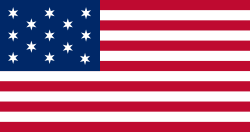 Congressman
Francis Hopkinson designed
a flag with six-pointed
white stars in staggered rows in the blue canton with a red and white striped
field. Congress approved the flag, commonly called the Hopkinson flag,
as the First Official Flag of the United
States of America.
In a letter to Congress, Hopkinson stated that he had not requested
compensation for the flag’s design, but “was now looking for a reward: a
Quarter Cask of the Public Wine.”
Congressman
Francis Hopkinson designed
a flag with six-pointed
white stars in staggered rows in the blue canton with a red and white striped
field. Congress approved the flag, commonly called the Hopkinson flag,
as the First Official Flag of the United
States of America.
In a letter to Congress, Hopkinson stated that he had not requested
compensation for the flag’s design, but “was now looking for a reward: a
Quarter Cask of the Public Wine.”
When I
gave this presentation to DAR Chapters last summer, I was
asked, “why George Washington favored the six
pointed star?” I learned that Washington did not want the public to think he
recommended five-pointed stars which are featured on his family coat-of-arms.
So he
favored
six-pointed ones.
Both the
Hopkinson and the Betsy Ross flags became known as the Stars and Stripes,
and
were displayed at Fort Morris by Colonel John McIntosh during the British
Demand for Surrender in
November 1778 and during
other Revolutionary battles in Georgia. Ironically today, the first official
Hopkinson Flag is virtually unknown, but the unofficial Betsy Ross Flag
is the most widely recognized flag of the American Revolution.
As you know, the British
were our enemies, along with their German Hessian mercenaries. Can you recall
which foreign country came to our aid and helped us win the Revolutionary War?
–
Answer is
The Kingdom of France.
Two
key
American Francophiles, Benjamin Franklin and Thomas Jefferson, were convinced
that America’s fate was linked with the people of France, or better the money
of King Louis XVI. Let me
describe the two French flags and how the French assisted us during the
Revolutionary War in Georgia.
4-- French Flags-
Banner of France
& French White Ensign
Starting in
1776,
France,
Spain and the
Dutch Republic had secretly provided
supplies, ammunition and weapons to Americans. A British invasion from
Canada, ended in the capture of the British army at the
Battle of Saratoga in New York in 1777. That American victory proved to be
the turning point of the Revolution; it persuaded France and their allies
to enter the war openly, thus balancing the military strength of Great
Britain. The American Revolutionary War which began as a war between the
Kingdom of Great Britain and the
Thirteen Colonies, gradually grew into a
world war with Britain on one side and the newly formed
United States,
France,
Netherlands and
Spain on the other.
Before
the French Revolution in 1790,
France had no
official national flag, but the Royal Bourbon Government had many flags. The
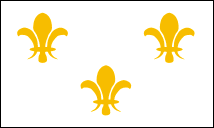 French Infantry fought under this
Banner of France,
a flag with a white field superimposed by three large gold
fleurdelisé,
which means “Flower of the
Lily.”
French Infantry fought under this
Banner of France,
a flag with a white field superimposed by three large gold
fleurdelisé,
which means “Flower of the
Lily.”
Paintings
of the French naval fleet at Yorktown illustrate ships flying this French
White Ensign- some with plain all-white banners with no discernible
“charge” and others flying this flag
with multiple
small gold
fleurdelisé
(charges)
in rows on the
white field. (The
plain all-white banner has become the flag to indicate surrender, and some –
especially the British-- attribute that designation to the all-white
French White Ensign, because of the frequent defeats of French military
forces.)
become the flag to indicate surrender, and some –
especially the British-- attribute that designation to the all-white
French White Ensign, because of the frequent defeats of French military
forces.)
In September 1779, almost
one year after Savannah had been captured by the
British, a
squadron of French Navy warships flying the French White Ensign and commanded
by Count Henri d’Estaing, arrived off the Georgia coast. Four thousand French
Infantry carrying the Banner of France disembarked near Savannah, and were
joined by 1,500 American troops under Major General Benjamin Lincoln, flying
the “Stars and Stripes.”
Admiral
d’Estaing demanded the immediate surrender of Savannah, but British General
Augustine Prevost refused. d’Estaing’s month-long delay in commencing the
combined Allied attack allowed Prevost to complete British defensive
fortifications around the city.
The Franco-American
frontal assault on the Spring Hill Redoubt, a location near the current
Savannah History Museum, began in the early morning of October 9th.
British artillery and musketry ripped the attackers. The French battle cry, “Vive
le roi!" was countered by the sounds of Scottish bagpipes.
British, Loyalist, and Hessian defenders cut down the few French and
Americans who reached the parapet. The attackers were unable to get inside the
redoubt, and the Siege of Savannah culminated in almost 1,000 Americans and
French killed.
After the
failure of the
Franco-American
attack, British retained control of Savannah until their evacuation in July of
1782.
Although the
Franco-American
attempt to retake Savannah was a stunning defeat, a French
naval victory near the
Chesapeake Bay led to a siege by combined French and Continental armies,
forcing British General Cornwallis to surrender at
Yorktown, Virginia in 1781.
5--
Regimental flags –
Display two flags: Pulaski Legion &
Fort Moultrie –
Military
units carried Regimental flags which were used extensively in recruiting and
training. But their primary use was to signal the battle movements of units
during the battle, and also to provide inspiration to rally troops at
important points.
I will describe two
of the American Regimental flags displayed during the ill-fated Franco-
American assault at Savannah which honorably reflect the actions of two heroes
who were mortally wounded during the battle-- Brigadier General Casimir
Pulaski and Sergeant William Jasper.
This
is the Banner of the
Pulaski Legion- On one side are
the letters “U.S.” encircled with words (in Latin): “United in Virtue and
Force.”

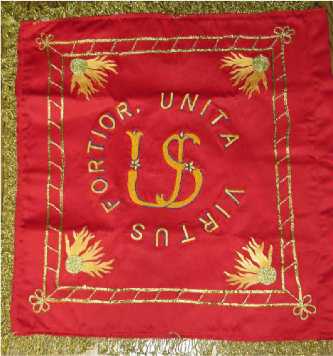
On the other side, “No Allegiance to King”
appears over the symbol of the “All-seeing Eye” with
thirteen eight-pointed stars. The “Eye” signified that God favored the
prosperity of the United 13 States. Moravian Nuns in Pennsylvania made the
square banner of crimson silk for Pulaski, and attached to a cavalry lance, it
was always carried in the vanguard of the Pulaski Legion.
During the Siege of Savannah, General Casimir
Pulaski, Polish-born commander of the Legion, received a mortal wound while
conducting a reconnaissance in search of a breach in the British lines.
Two days later, Pulaski, considered the “Father of
American Cavalry,” died of
his wounds.
This
Flag
(Fort
Moultrie Flag)
was commissioned by
Colonel
William Moultrie for the South
Carolina Minutemen to
prepare for war with Britain. A white
heraldic symbol, like a crescent
moon, is displayed with
the word “LIBERTY”
on a dark blue field.

During the battle of
Sullivan's Island, this regimental flag fell when the bearer was killed,
but Sergeant
William Jasper, displaying great heroism, retrieved and hoisted the flag,
claiming, “We cannot fight without a
flag,” thus rallying the
Patriots for the successful defense against the
British fleet. When Fort Sullivan was renamed to honor Colonel
Moultrie, the flag became known as the Fort Moultrie Flag and has evolved
into the flag of the state of South Carolina.
Three years later
during the
Siege of Savannah, Sergeant William Jasper
received a mortal wound while attempting to
plant his regimental blue flag upon the British entrenchments.
In Madison Square in Savannah, a
dramatic monument portrays Sergeant Jasper’s attempt to raise the flag to
motivate the American and French troops.
The American Revolution greatly affected the
hearts and minds of Georgians who sought to memorialize these two Patriots,
General Casimir Pulaski and Sergeant William Jasper, by naming counties for
them, along with 62 other figures evocative of these historic times. With this
rich inheritance, Georgians demonstrate honor for the named Patriots, as well
as the many other men and women who fought and supported the American
Revolution.
Bill
Ramsaur, Marshes of Glynn Chapter, Georgia Society Sons of the American
Revolution wframsaur@aol.com